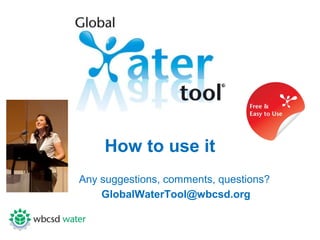
How to Manage Global Water Risks
- 1. How to use it Any suggestions, comments, questions? GlobalWaterTool@wbcsd.org
- 2. Water Situation in the World The right kind of water needs to be in the right place at the right time, but that’s not always the case Too much Too little Too bad 2
- 3. Implications for global companies Risk • Increased attention on water as a metric for business performance • Manage risks: operational, reputational, regulatory, products & markets, and financial • Severity will depend on impacts which are determined by local conditions • Organizations with few water impacts may face many water-related risks Opportunity • Source of revenue generating solutions • Certification in the marketplace 3
- 4. Corporate Water Risk Management • Requires an understanding of a company’s water needs in relation to local conditions • In your operations, supply chain and ultimately customers – entire value chain • Low volume does not necessarily mean low risk – impacts depend on watershed situation • Need to collaborate with other users (“shared resource”) To manage your water globally, you need to understand the water situation locally and beyond your own operations
- 5. The Global Water Tool Maps a company’s water use and helps assess risks by comparing sites, suppliers and workers location with external data • How many of your sites are in water-scarce areas? Which sites are at greater risk? • How much of your total production is generated from your most-at-risk sites? • How many of your suppliers will be in water-stressed regions in the future? • How many of your employees live in countries that lack access to water and sanitation? “The Global Water Tool is the first step for any company to make water-informed decisions”
- 6. What does it do? Calculates water consumption, efficiency and intensity metrics Establishes relative water risks allowing prioritization of actions Creates water reporting indicators Enables effective communication with internal and external stakeholders Provides context to a company’s water use based on almost 30 external datasets 6
- 7. How does it work? Excel workbook – company site location (lat/long) and water use information – automatically provides outputs (eg inventory, reporting indicators and charts combining company data with country and watershed data) Online mapping – companies can plot sites with external water datasets and download onto maps – connected to Google Earth 7
- 8. Outputs (I): charts and maps • Only requires to include geographical coordinates of sites/suppliers Outputs (I): charts and maps On a country and watershed • Projected total renewable water per person 2025 & 2050 (FAO) basis - for example: • Industrial water withdrawal as par of total (FAO) • Access to improved drinking water & sanitation (WHO/UNICEF) • Environmental Water Scarcity Index (IWMI) • Urban growth rates (UN Population Division) 8
- 9. Projected annual renewable supply per person (2025) INCLUDE ANIMATION – BLANK MAP AND COLORED MAP (FADE) Supplier Office Retail Industrial
- 10. Outputs (II) based on excel Outputs (II): excel workbook • Requires site water use data – Water inventory (consumption, intensity, recycling / reuse) – Reporting indicators (GRI, Bloomberg, DJSI and CDP)
- 11. Company feedback Company experience Engagement tool – Inform executives of potential water availability risks – Conduct close dialogues with major sites located in water-stress regions leading to local assessments at those sites – Educate supply chain partners, initiate capacity building, develop projects with local communities Strategic planning – Prioritize action and further quantification of risks – Assist in screening new major projects – Baseline to start monitoring progress in a consistent way – Fine tune goals so that they better align with true regional concerns External reporting – Companies’ sustainability reports – CDP submissions, CEO Water Mandate Communication on Progress 11
- 12. The Global Water Tool 2011 Latest developments 1. Customizations Industrial sectors: Power Utilities and Oil & Gas Geographies: India and China 2. Complementing global risk assessment with site level management The GEMI Local Water Tool 3. Understanding the dynamic waterscape promote engagement drive coordination and some harmonization help business combine tools to yield an effective approach 12
- 13. Need more info? Go to: www.wbcsd.org – Download the tools freely – FAQs, dataset details definitions – How to use guides Any suggestions, comments, questions? GlobalWaterTool@wbcsd.org
Notas do Editor
- Awareness with high level executives of the essential role of water in operations + basis for internal benchmarking (water intensity per unit of production + rates of recycling and reuse)
- Country level data (charts and maps): Total renewable water resources per person + projections to 2025 and 2050 (FAO) Total water withdrawal per person (FAO) Industrial water withdrawal as part of total (FAO) Population served with improved water (WHO/UNICEF) Population served with improved sanitation (WHO/UNICEF) Dependency ratio (FAO) Urban annual growth rate (UN) Watershed level data (charts and maps): Annual renewable water supply per person 1995 and 2025 (WRI) Mean annual relative water stress index (UNH) Environmental water scarcity index (IWMI) Physical and economic water scarcity (IWMI) Biodiversity hotspots (CI)
- By watershed scarcity level, it calculates: Water withdrawal, discharge and consumption Water recycling, efficiency and intensity metrics
- Data input and metrics output in the Excel file are customized to the four main types of power production: thermal, geothermal, solar photovoltaic/wind, hydro. Cooling water is considered separately from other process water. Influent and effluent quality parameters (total dissolved solids) are included. Data input and metrics output in the Excel file are customized to the eight main parts of the Oil and Gas Value Chain: Drilling, production, oil sands, transport, gas processing, refining, petrochemicals, retail